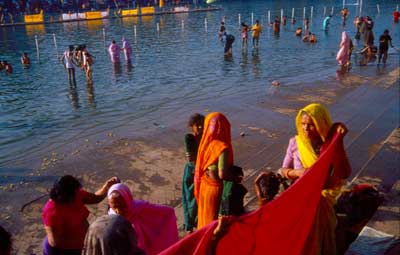|
Special Features
Simhastha Kumbha at Nashik, 2015 |
|||||
The Maha Kumbh is celebrated at Nashik every 12 years. The great bathing festival of the Kumbh Mela at Nashik is in 2015. The Kumbh Snan Parva is much more significant than a ritualistic dip in the holy Gautami Ganga river. It is a tribute to the Hindu way of life, an affirmation of faith and a renewal of our deep-seated beliefs. The holy bath at a Kumbha is said to be equal in merit to thousands of snans during the month of Kartik, hundreds of Magh snans and crore snan in the river Narmada during Vaishakh. It's fruit is said to be equivalent to thousands of Ashwamegh Yajna, hundreds of Vajpaye Yajna, and lakhs of parikrama around the world. When Jupiter is in Leo and the Sun and Moon are in Cancer, the legends of the Gautami Ganga and of the jyotirlinga at Tryambakeshwar are revealed in age-old tradition during the Simhastha Kumbha, the supremely sacred conjunction of time and space that beckons the faithful for the auspicious snan. |
More on Kumbha •Nashik Kumbha 2015 • Ujjain 2016 • Legends of Kumbha • Practical Guide • Sadhus at Kumbha • Photo Gallery 1 • Photo Gallery 2 • Photo Gallery 3 • Kumbh Haridwar 2010 • Kumbha Allahabad 2013 • Ujjain 2004 • Notes from the Kumbh • Friend to Sage • Vignettes Kumbha Cities • Ujjain • Haridwar • Allahabad • Nashik |
||||
 Snan Parva or Bathing Dates
Snan Parva or Bathing Dates
The Kumbh is mythologically related to the churning of the oceans to extract amrit or the nectar of immortality. The devatas or gods and the asuras or demons, together churned the oceans. The pot of ambrosia was handed to Brihaspati, (Jupiter) Surya,(Sun) Chandra (Moon) and Shani (Saturn). In the process of the ensuing tussle to get it, which lasted 12 god-days, equal to 12 human years, a few drops spilled from the kumbh or pitcher in which the Amrita was being carried. This nectar fell at Allahabad, Haridwar, Nasik and Ujjain, sanctifying these places.
The Kumbha Mela is held at these four sacred places - on the banks of the holy Ganga at Haridwar where it descends from the mighty Himalayas to the plains of India, at the confluence of the Ganga, Yamuna and the mythical Saraswati called the Triveni Sangam at Prayag or Allahabad, beside the river Kshipra at Ujjain and on the banks of the Godavari at Nasik. At each of the four places the Kumbh festival is celebrated once every twelve years, coinciding with one round of Jupiter through the zodiac. Since the three cosmic powers played their role, the Kumbha is celebrated when Jupiter, the Sun and Moon are in particular astrological positions in the almanac. When Jupiter is in in the sign of Aquarius, when the sun is in Aries and Moon is in Sagittarius, the Auspicious Kumbh at Haridwar occurs. When Jupiter is in Taurus and the Sun and Moon in Capricorn, it is celebrated at Prayag or Allahabad. At Nasik it is held when Jupiter is in Leo and the Sun and Moon are in Cancer. At Ujjain the Kumbh Mela occurs when Jupiter is in Leo and the Sun and Moon in Aries. The Kumbha Mela at Ujjain and Nasik are known as Simhastha because various planets transit in Simha Rashi (Zodiac Leo). When the Sun enters Mesh Rashi (Aries) and Jupiter enters Simha Rashi, the Kumbha is celebrated at Nashik, where it was last celebrated in August 2003, and is being celebrated during the monsoon months of 2015.
|
|||||
Editor: Romola Butalia (c) India Travelogue. All rights reserved. |
|||||